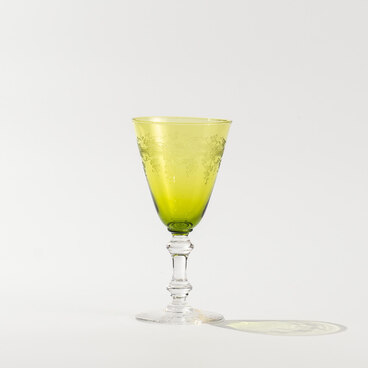A pitcher is one of the oldest types of vessels. Our ancestors used it for storing and serving liquids, for washing, and for conducting church rituals. Sometimes, pitchers were even used for church construction as resonators: they were embedded into the base of the dome along its entire circumference so that only their openings were exposed to absorb the echo.
This pitcher was made of colorless glass and decorated with green glass mass using the technique known as the “tangled thread”. This technique belongs to the free blowing method where the glass is decorated immediately at the glass melting furnace. The Russian term for this technique “gutnaya” most likely originated from the Latin word “gutta” meaning “a drop”. In this case, it is a drop of hot glass mass. The glass is blown at a temperature of around 1000 ºС. When this technique is used, the heated body of the product is wrapped with a thread of molten glass mass of another color (heated to a temperature of around 1300 ºС).
The green color of the glass mass is obtained by using chromium oxides. They are sometimes used together with copper oxides to achieve bluish-green shades. There are two types of glass coloring: ionic and colloidal. The method using chromium compounds belongs to the ionic type of glass mass coloring. The pitcher’s outer surface is iridescent. Iridizing is a method of decorating the glass surface by creating a rainbow-like effect. It is achieved by fuming heated glass with the salts of certain metals which form an iridescent film of the oxides of such metals on the glass surface. Only heated products can be fumed because otherwise, the glass takes on a dull white deposit without any iridescence. Most often, tin, bismuth, titanium, barium, and strontium salts are used for iridizing. These salts evaporate without melting. They sublime on the glass surface, that is, the vapor forms a solid deposit on the surface. Iridizing is a simple and inexpensive method of decorating the glass surface. The film connects to the glass surface, it is waterproof and wearproof. Iridized glass may be colorless or light-colored (when observed in transmitted light). The film creates a rainbow-like effect only in reflected light. Such a play of light can also be seen in soap bubbles or an oily film on water.
This pitcher was made of colorless glass and decorated with green glass mass using the technique known as the “tangled thread”. This technique belongs to the free blowing method where the glass is decorated immediately at the glass melting furnace. The Russian term for this technique “gutnaya” most likely originated from the Latin word “gutta” meaning “a drop”. In this case, it is a drop of hot glass mass. The glass is blown at a temperature of around 1000 ºС. When this technique is used, the heated body of the product is wrapped with a thread of molten glass mass of another color (heated to a temperature of around 1300 ºС).
The green color of the glass mass is obtained by using chromium oxides. They are sometimes used together with copper oxides to achieve bluish-green shades. There are two types of glass coloring: ionic and colloidal. The method using chromium compounds belongs to the ionic type of glass mass coloring. The pitcher’s outer surface is iridescent. Iridizing is a method of decorating the glass surface by creating a rainbow-like effect. It is achieved by fuming heated glass with the salts of certain metals which form an iridescent film of the oxides of such metals on the glass surface. Only heated products can be fumed because otherwise, the glass takes on a dull white deposit without any iridescence. Most often, tin, bismuth, titanium, barium, and strontium salts are used for iridizing. These salts evaporate without melting. They sublime on the glass surface, that is, the vapor forms a solid deposit on the surface. Iridizing is a simple and inexpensive method of decorating the glass surface. The film connects to the glass surface, it is waterproof and wearproof. Iridized glass may be colorless or light-colored (when observed in transmitted light). The film creates a rainbow-like effect only in reflected light. Such a play of light can also be seen in soap bubbles or an oily film on water.



